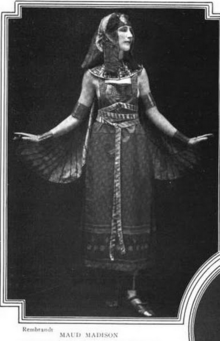Maud Madison
Maud Madison | |
|---|---|
 Maud Madison, from a 1916 publication. | |
| Born | November 19, 1870 |
| Died | October 4, 1953 (aged 82) Hollywood, California, U.S. |
| Occupation(s) | Dancer, actress |
| Children | Beatrice Maude |
Maud Madison (November 19, 1870 – October 4, 1953) was an American actress and dancer.
Early life
[edit]Maud Madison was born in San Francisco, California. She was the daughter of actress and suffragist Julie Reinhardt (1844–1924).[1][2] She completed studies at the Boucicault School of Acting in 1889.[3]
Career
[edit]Madison started her stage career as an actress in touring companies, and appeared with English actor Richard Mansfield in Richard III.[3] By 1893,[4] she was described primarily as a dancer, specializing in performance of the "crinoline dance"[5] or skirt dance, a popular trend of the day.[6][7] In 1900 she danced with Loie Fuller in Paris, at the Exposition Universelle.[8] While in Paris, she also danced in a cage of lions as a publicity stunt.[9] In 1910, she danced at the opening of the Colonial Opera House in Hamilton, Bermuda.[10]
Inspired by Fuller, Madison took a particular interest in lighting effects and innovative costuming for her performances. She amazed audiences when flags and famous portraits were projected onto her skirts while they whirled and fluttered.[11] "Miss Madison is the originator or many novel effects in ballroom exhibition dances," explained the San Francisco Chronicle in 1916.[12] Madison toured the United States that year, with poet Charles Keeler,[13] interpreting his poems in dances such as "The Harper's Song of Isis" (an Egyptian art-inspired dance), "The Vampire" (a bat-themed dance) and "Princess Papilio" (a butterfly-themed dance).[14] She also taught social dance steps in New York City.[3]
Personal life
[edit]Madison had a daughter, Beatrice Maude, who became an actress. Madison died in 1953, at home in Hollywood, California.[15] A collection of her papers is archived in the Jerome Robbins Dance Division of the New York Public Library.[3]
References
[edit]- ^ "Julie Reinhardt at Rest, as Broadway Still Forgets". Daily News. September 3, 1924. p. 64. Retrieved April 18, 2019 – via Newspapers.com.
- ^ "Aged Suffragist Dies in Poverty". Courier-Post. August 30, 1924. p. 2. Retrieved April 18, 2019 – via Newspapers.com.
- ^ a b c d "archives.nypl.org -- Maud Madison papers". archives.nypl.org. Retrieved 2019-04-18.
- ^ "Clever Maud Madison". Lincoln Evening Call. March 19, 1893. p. 7. Retrieved April 18, 2019 – via Newspapers.com.
- ^ "Dances in a Hoop Skirt". The World. February 22, 1893. p. 6. Retrieved April 18, 2019 – via Newspapers.com.
- ^ "The Crinoline Dance". The Baltimore Sun. March 27, 1893. p. 1. Retrieved April 18, 2019 – via Newspapers.com.
- ^ Nancy A. Hewitt, "Varieties of Voluntarism: Class, Ethnicity, and Women's Activism in Tampa" in Louise A. Tilly and Patricia Gurin, eds., Women, Politics and Change (Russell Sage Foundation 1990): 75. ISBN 9781610445344
- ^ "Maud Madison's Entertainment". The Florida Star. February 7, 1902. p. 1. Retrieved April 18, 2019 – via Newspapers.com.
- ^ Hindson, Catherine (December 2008). "Interruptions by Inevitable Petticoats: Skirt Dancing and the Historiographical Problem of Late Nineteenth-Century Dance". Nineteenth Century Theatre and Film. 35 (2): 48–64. doi:10.7227/NCTF.35.2.5. ISSN 1748-3727. S2CID 194069479.
- ^ "Bermuda's New Theatre". The New York Times. January 16, 1910. p. 16 – via ProQuest.
- ^ "Maud Madison Coming". The Daytona Gazette-News. January 25, 1902. p. 2. Retrieved April 17, 2019 – via Newspapers.com.
- ^ Erhard, Ursinus (April 23, 1916). "California Entertainers Score a Hit in New York". San Francisco Chronicle. p. 42. Retrieved April 18, 2019 – via Newspapers.com.
- ^ "Interesting Personalities in the World of the Stage". The Theatre. 24: 80. August 1916.
- ^ Maclay, Mira Abbott (July 1916). "Charles Keeler, Poet". Overland Monthly. 68: 68.
- ^ "Miss Maud Madison". The New York Times. October 9, 1953. p. 27 – via ProQuest.
